Human Resource Development Proposal for Nurses at Emerald Aged Care
VerifiedAdded on 2023/01/20
|11
|2815
|79
Report
AI Summary
This report presents a comprehensive Human Resource Development (HRD) proposal designed for the nurses at Emerald Aged Care. The proposal outlines a 12-month learning and development plan based on a thorough training needs assessment, which identified the need for enhanced skills in aged care, flexible career development opportunities, and time constraints for training. The proposal includes a detailed overview of the organization, its objectives, and the competency gaps of the nurses. It suggests key learning and development interventions such as functional training, emotional intelligence training, and specialized technical training. The report discusses the training methods, including lectures, audio-visual aids, and simulations, and provides an evaluation plan to assess the program's effectiveness. The document emphasizes the importance of aligning the training with the organization's goals and ensuring a supportive environment for knowledge transfer and application. The proposal concludes with a summary of the proposed strategy and a call for a detailed evaluation and review of the implemented interventions.
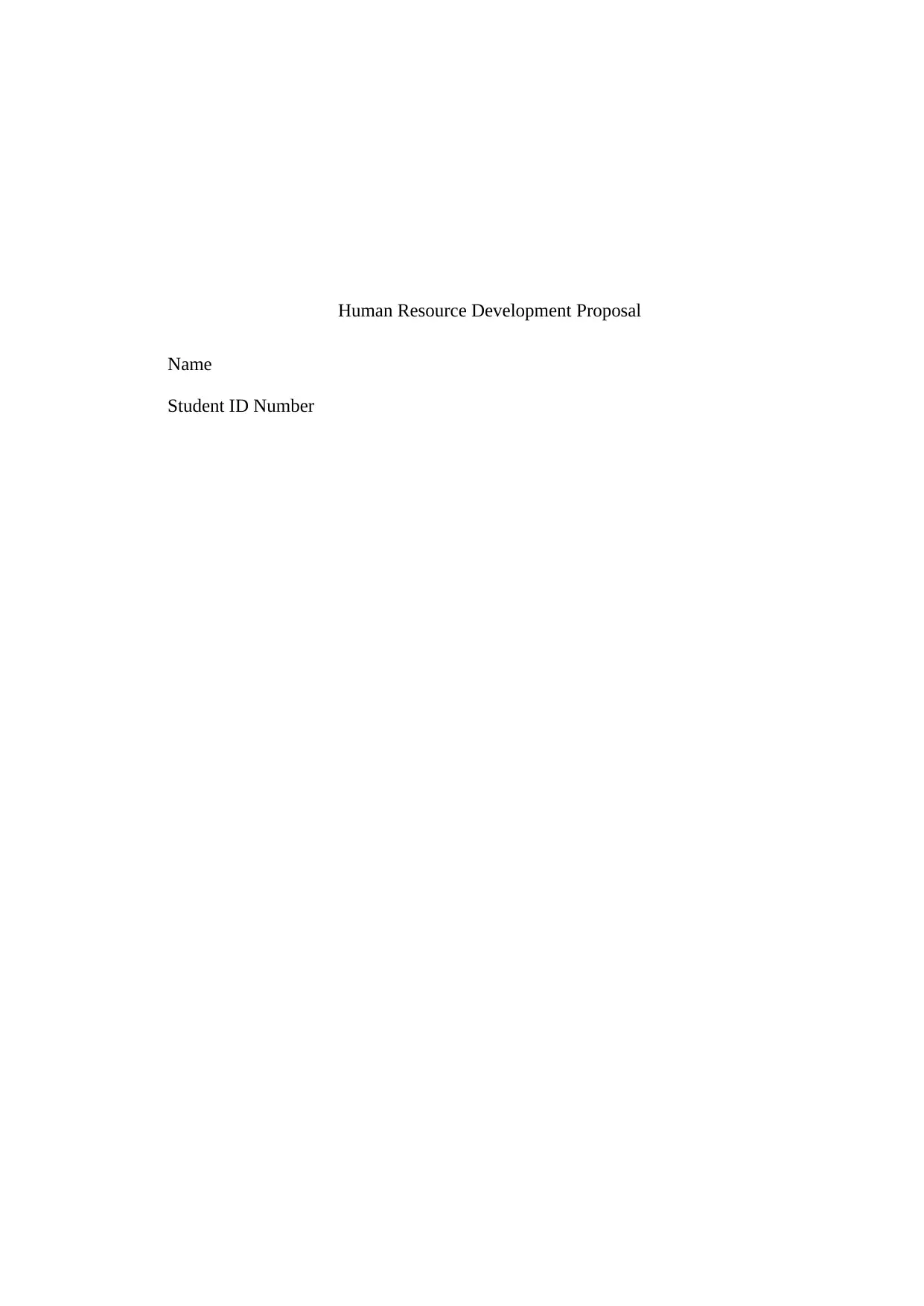
Human Resource Development Proposal
Name
Student ID Number
Name
Student ID Number
Paraphrase This Document
Need a fresh take? Get an instant paraphrase of this document with our AI Paraphraser
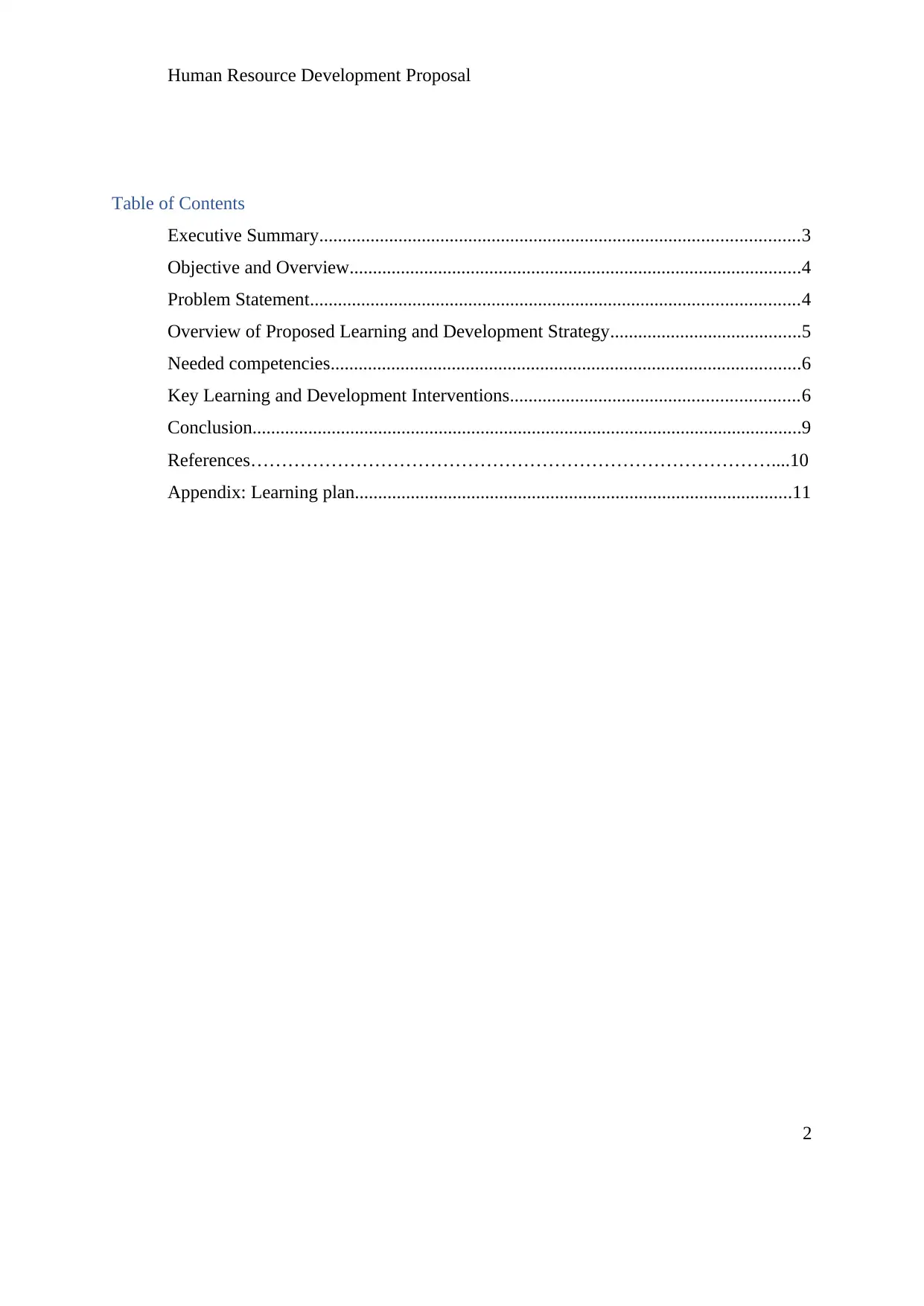
Human Resource Development Proposal
Table of Contents
Executive Summary.......................................................................................................3
Objective and Overview.................................................................................................4
Problem Statement.........................................................................................................4
Overview of Proposed Learning and Development Strategy.........................................5
Needed competencies.....................................................................................................6
Key Learning and Development Interventions..............................................................6
Conclusion......................................................................................................................9
References…………………………………………………………………………....10
Appendix: Learning plan..............................................................................................11
2
Table of Contents
Executive Summary.......................................................................................................3
Objective and Overview.................................................................................................4
Problem Statement.........................................................................................................4
Overview of Proposed Learning and Development Strategy.........................................5
Needed competencies.....................................................................................................6
Key Learning and Development Interventions..............................................................6
Conclusion......................................................................................................................9
References…………………………………………………………………………....10
Appendix: Learning plan..............................................................................................11
2
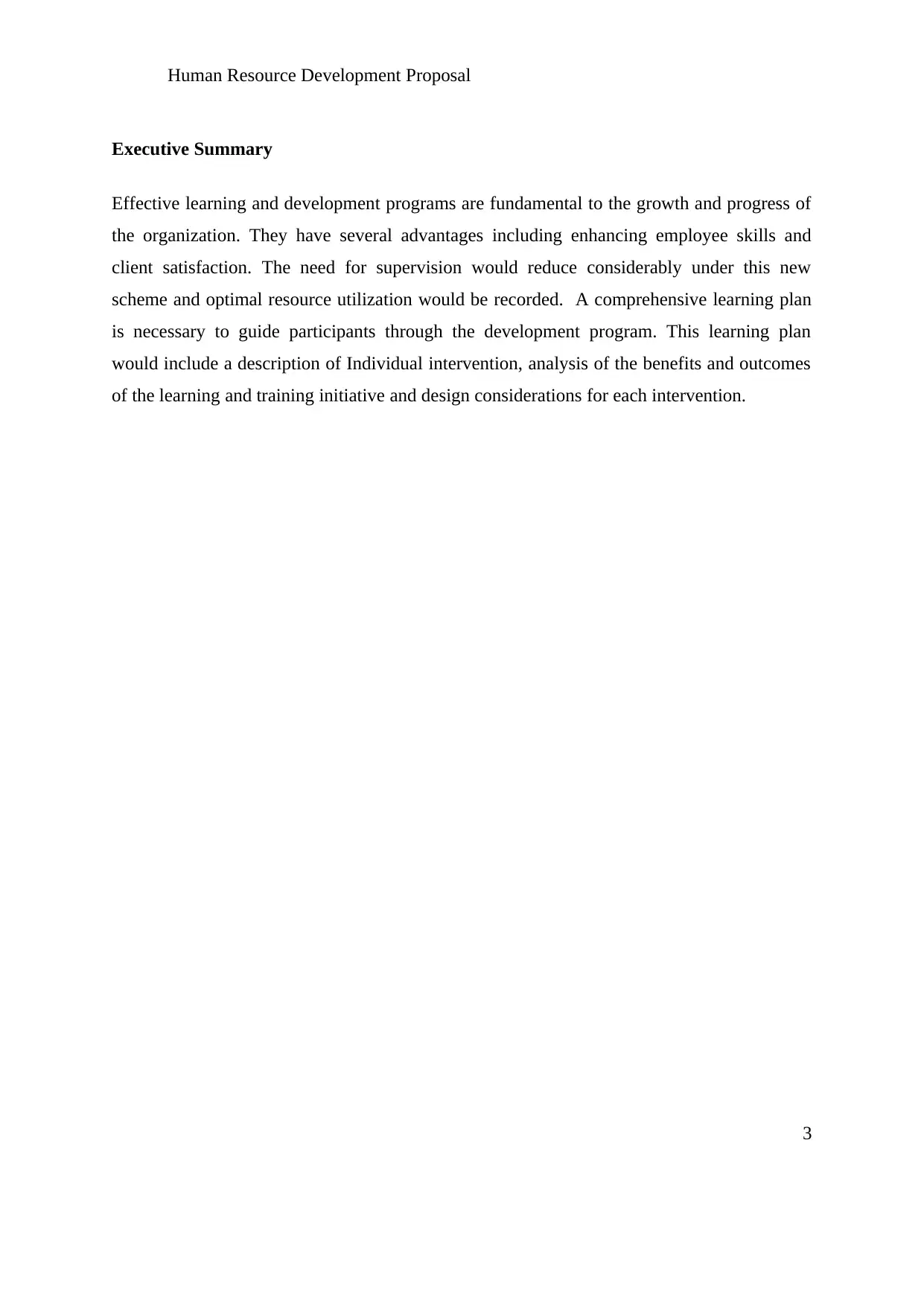
Human Resource Development Proposal
Executive Summary
Effective learning and development programs are fundamental to the growth and progress of
the organization. They have several advantages including enhancing employee skills and
client satisfaction. The need for supervision would reduce considerably under this new
scheme and optimal resource utilization would be recorded. A comprehensive learning plan
is necessary to guide participants through the development program. This learning plan
would include a description of Individual intervention, analysis of the benefits and outcomes
of the learning and training initiative and design considerations for each intervention.
3
Executive Summary
Effective learning and development programs are fundamental to the growth and progress of
the organization. They have several advantages including enhancing employee skills and
client satisfaction. The need for supervision would reduce considerably under this new
scheme and optimal resource utilization would be recorded. A comprehensive learning plan
is necessary to guide participants through the development program. This learning plan
would include a description of Individual intervention, analysis of the benefits and outcomes
of the learning and training initiative and design considerations for each intervention.
3
⊘ This is a preview!⊘
Do you want full access?
Subscribe today to unlock all pages.

Trusted by 1+ million students worldwide
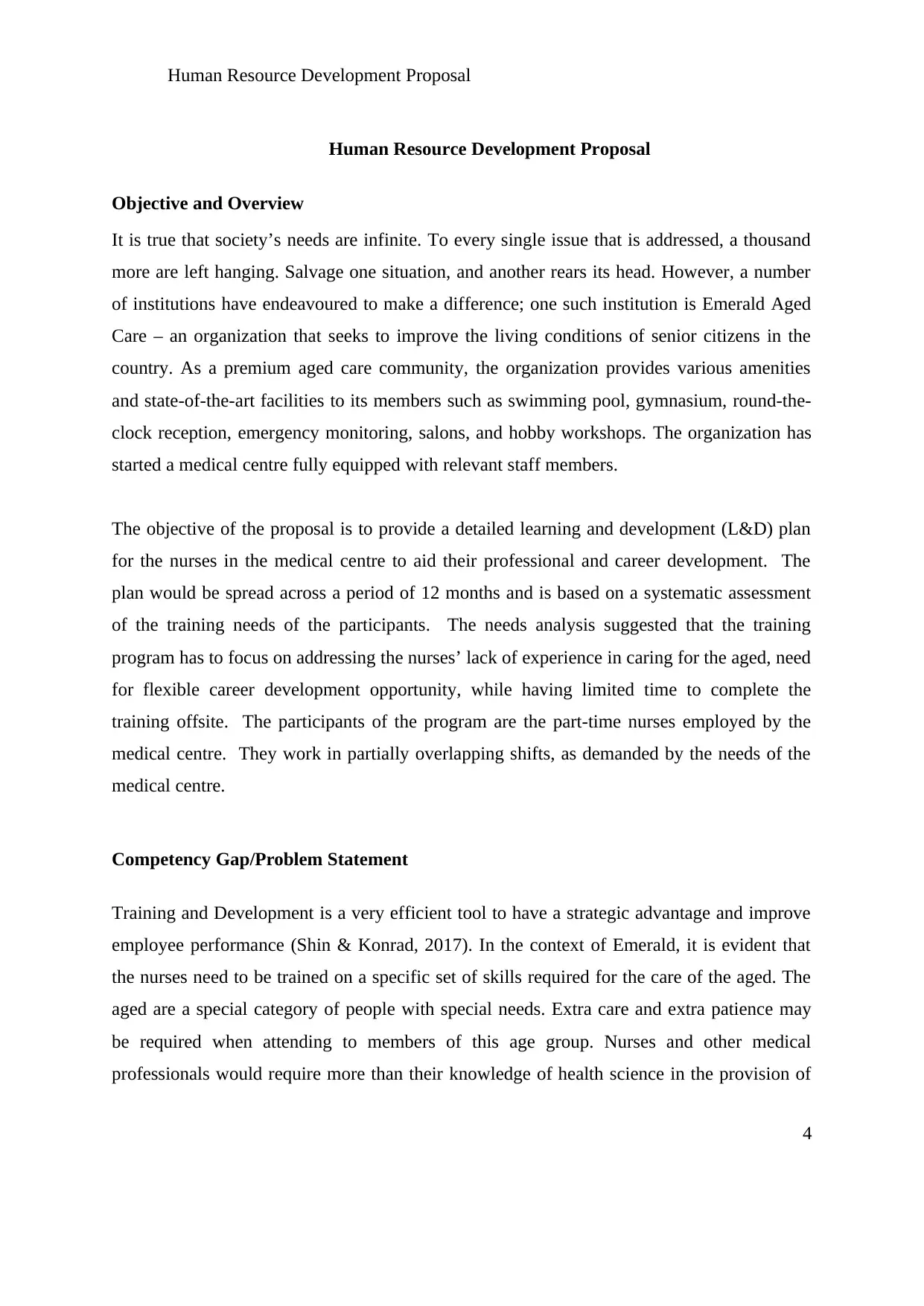
Human Resource Development Proposal
Human Resource Development Proposal
Objective and Overview
It is true that society’s needs are infinite. To every single issue that is addressed, a thousand
more are left hanging. Salvage one situation, and another rears its head. However, a number
of institutions have endeavoured to make a difference; one such institution is Emerald Aged
Care – an organization that seeks to improve the living conditions of senior citizens in the
country. As a premium aged care community, the organization provides various amenities
and state-of-the-art facilities to its members such as swimming pool, gymnasium, round-the-
clock reception, emergency monitoring, salons, and hobby workshops. The organization has
started a medical centre fully equipped with relevant staff members.
The objective of the proposal is to provide a detailed learning and development (L&D) plan
for the nurses in the medical centre to aid their professional and career development. The
plan would be spread across a period of 12 months and is based on a systematic assessment
of the training needs of the participants. The needs analysis suggested that the training
program has to focus on addressing the nurses’ lack of experience in caring for the aged, need
for flexible career development opportunity, while having limited time to complete the
training offsite. The participants of the program are the part-time nurses employed by the
medical centre. They work in partially overlapping shifts, as demanded by the needs of the
medical centre.
Competency Gap/Problem Statement
Training and Development is a very efficient tool to have a strategic advantage and improve
employee performance (Shin & Konrad, 2017). In the context of Emerald, it is evident that
the nurses need to be trained on a specific set of skills required for the care of the aged. The
aged are a special category of people with special needs. Extra care and extra patience may
be required when attending to members of this age group. Nurses and other medical
professionals would require more than their knowledge of health science in the provision of
4
Human Resource Development Proposal
Objective and Overview
It is true that society’s needs are infinite. To every single issue that is addressed, a thousand
more are left hanging. Salvage one situation, and another rears its head. However, a number
of institutions have endeavoured to make a difference; one such institution is Emerald Aged
Care – an organization that seeks to improve the living conditions of senior citizens in the
country. As a premium aged care community, the organization provides various amenities
and state-of-the-art facilities to its members such as swimming pool, gymnasium, round-the-
clock reception, emergency monitoring, salons, and hobby workshops. The organization has
started a medical centre fully equipped with relevant staff members.
The objective of the proposal is to provide a detailed learning and development (L&D) plan
for the nurses in the medical centre to aid their professional and career development. The
plan would be spread across a period of 12 months and is based on a systematic assessment
of the training needs of the participants. The needs analysis suggested that the training
program has to focus on addressing the nurses’ lack of experience in caring for the aged, need
for flexible career development opportunity, while having limited time to complete the
training offsite. The participants of the program are the part-time nurses employed by the
medical centre. They work in partially overlapping shifts, as demanded by the needs of the
medical centre.
Competency Gap/Problem Statement
Training and Development is a very efficient tool to have a strategic advantage and improve
employee performance (Shin & Konrad, 2017). In the context of Emerald, it is evident that
the nurses need to be trained on a specific set of skills required for the care of the aged. The
aged are a special category of people with special needs. Extra care and extra patience may
be required when attending to members of this age group. Nurses and other medical
professionals would require more than their knowledge of health science in the provision of
4
Paraphrase This Document
Need a fresh take? Get an instant paraphrase of this document with our AI Paraphraser
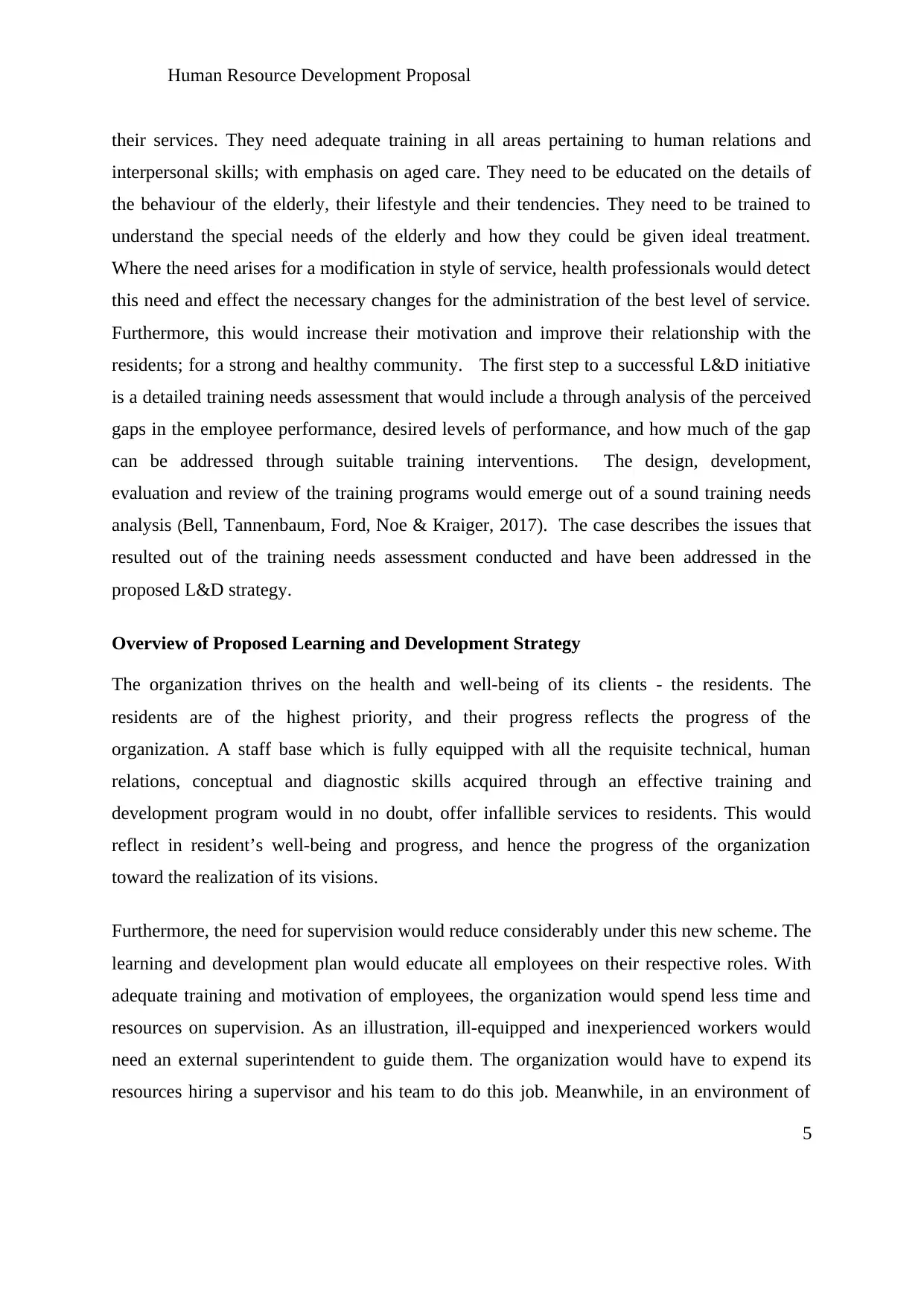
Human Resource Development Proposal
their services. They need adequate training in all areas pertaining to human relations and
interpersonal skills; with emphasis on aged care. They need to be educated on the details of
the behaviour of the elderly, their lifestyle and their tendencies. They need to be trained to
understand the special needs of the elderly and how they could be given ideal treatment.
Where the need arises for a modification in style of service, health professionals would detect
this need and effect the necessary changes for the administration of the best level of service.
Furthermore, this would increase their motivation and improve their relationship with the
residents; for a strong and healthy community. The first step to a successful L&D initiative
is a detailed training needs assessment that would include a through analysis of the perceived
gaps in the employee performance, desired levels of performance, and how much of the gap
can be addressed through suitable training interventions. The design, development,
evaluation and review of the training programs would emerge out of a sound training needs
analysis (Bell, Tannenbaum, Ford, Noe & Kraiger, 2017). The case describes the issues that
resulted out of the training needs assessment conducted and have been addressed in the
proposed L&D strategy.
Overview of Proposed Learning and Development Strategy
The organization thrives on the health and well-being of its clients - the residents. The
residents are of the highest priority, and their progress reflects the progress of the
organization. A staff base which is fully equipped with all the requisite technical, human
relations, conceptual and diagnostic skills acquired through an effective training and
development program would in no doubt, offer infallible services to residents. This would
reflect in resident’s well-being and progress, and hence the progress of the organization
toward the realization of its visions.
Furthermore, the need for supervision would reduce considerably under this new scheme. The
learning and development plan would educate all employees on their respective roles. With
adequate training and motivation of employees, the organization would spend less time and
resources on supervision. As an illustration, ill-equipped and inexperienced workers would
need an external superintendent to guide them. The organization would have to expend its
resources hiring a supervisor and his team to do this job. Meanwhile, in an environment of
5
their services. They need adequate training in all areas pertaining to human relations and
interpersonal skills; with emphasis on aged care. They need to be educated on the details of
the behaviour of the elderly, their lifestyle and their tendencies. They need to be trained to
understand the special needs of the elderly and how they could be given ideal treatment.
Where the need arises for a modification in style of service, health professionals would detect
this need and effect the necessary changes for the administration of the best level of service.
Furthermore, this would increase their motivation and improve their relationship with the
residents; for a strong and healthy community. The first step to a successful L&D initiative
is a detailed training needs assessment that would include a through analysis of the perceived
gaps in the employee performance, desired levels of performance, and how much of the gap
can be addressed through suitable training interventions. The design, development,
evaluation and review of the training programs would emerge out of a sound training needs
analysis (Bell, Tannenbaum, Ford, Noe & Kraiger, 2017). The case describes the issues that
resulted out of the training needs assessment conducted and have been addressed in the
proposed L&D strategy.
Overview of Proposed Learning and Development Strategy
The organization thrives on the health and well-being of its clients - the residents. The
residents are of the highest priority, and their progress reflects the progress of the
organization. A staff base which is fully equipped with all the requisite technical, human
relations, conceptual and diagnostic skills acquired through an effective training and
development program would in no doubt, offer infallible services to residents. This would
reflect in resident’s well-being and progress, and hence the progress of the organization
toward the realization of its visions.
Furthermore, the need for supervision would reduce considerably under this new scheme. The
learning and development plan would educate all employees on their respective roles. With
adequate training and motivation of employees, the organization would spend less time and
resources on supervision. As an illustration, ill-equipped and inexperienced workers would
need an external superintendent to guide them. The organization would have to expend its
resources hiring a supervisor and his team to do this job. Meanwhile, in an environment of
5
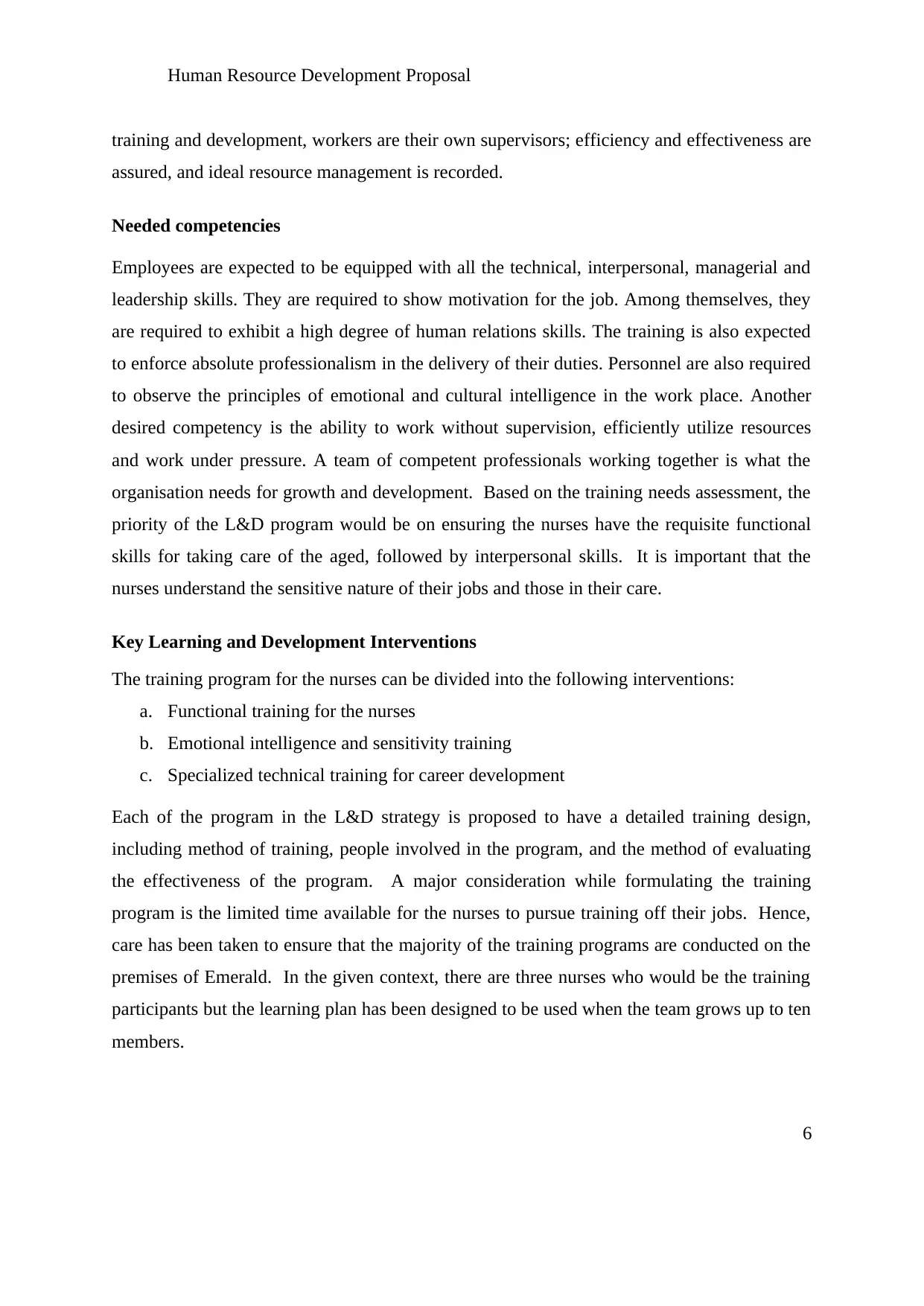
Human Resource Development Proposal
training and development, workers are their own supervisors; efficiency and effectiveness are
assured, and ideal resource management is recorded.
Needed competencies
Employees are expected to be equipped with all the technical, interpersonal, managerial and
leadership skills. They are required to show motivation for the job. Among themselves, they
are required to exhibit a high degree of human relations skills. The training is also expected
to enforce absolute professionalism in the delivery of their duties. Personnel are also required
to observe the principles of emotional and cultural intelligence in the work place. Another
desired competency is the ability to work without supervision, efficiently utilize resources
and work under pressure. A team of competent professionals working together is what the
organisation needs for growth and development. Based on the training needs assessment, the
priority of the L&D program would be on ensuring the nurses have the requisite functional
skills for taking care of the aged, followed by interpersonal skills. It is important that the
nurses understand the sensitive nature of their jobs and those in their care.
Key Learning and Development Interventions
The training program for the nurses can be divided into the following interventions:
a. Functional training for the nurses
b. Emotional intelligence and sensitivity training
c. Specialized technical training for career development
Each of the program in the L&D strategy is proposed to have a detailed training design,
including method of training, people involved in the program, and the method of evaluating
the effectiveness of the program. A major consideration while formulating the training
program is the limited time available for the nurses to pursue training off their jobs. Hence,
care has been taken to ensure that the majority of the training programs are conducted on the
premises of Emerald. In the given context, there are three nurses who would be the training
participants but the learning plan has been designed to be used when the team grows up to ten
members.
6
training and development, workers are their own supervisors; efficiency and effectiveness are
assured, and ideal resource management is recorded.
Needed competencies
Employees are expected to be equipped with all the technical, interpersonal, managerial and
leadership skills. They are required to show motivation for the job. Among themselves, they
are required to exhibit a high degree of human relations skills. The training is also expected
to enforce absolute professionalism in the delivery of their duties. Personnel are also required
to observe the principles of emotional and cultural intelligence in the work place. Another
desired competency is the ability to work without supervision, efficiently utilize resources
and work under pressure. A team of competent professionals working together is what the
organisation needs for growth and development. Based on the training needs assessment, the
priority of the L&D program would be on ensuring the nurses have the requisite functional
skills for taking care of the aged, followed by interpersonal skills. It is important that the
nurses understand the sensitive nature of their jobs and those in their care.
Key Learning and Development Interventions
The training program for the nurses can be divided into the following interventions:
a. Functional training for the nurses
b. Emotional intelligence and sensitivity training
c. Specialized technical training for career development
Each of the program in the L&D strategy is proposed to have a detailed training design,
including method of training, people involved in the program, and the method of evaluating
the effectiveness of the program. A major consideration while formulating the training
program is the limited time available for the nurses to pursue training off their jobs. Hence,
care has been taken to ensure that the majority of the training programs are conducted on the
premises of Emerald. In the given context, there are three nurses who would be the training
participants but the learning plan has been designed to be used when the team grows up to ten
members.
6
⊘ This is a preview!⊘
Do you want full access?
Subscribe today to unlock all pages.

Trusted by 1+ million students worldwide
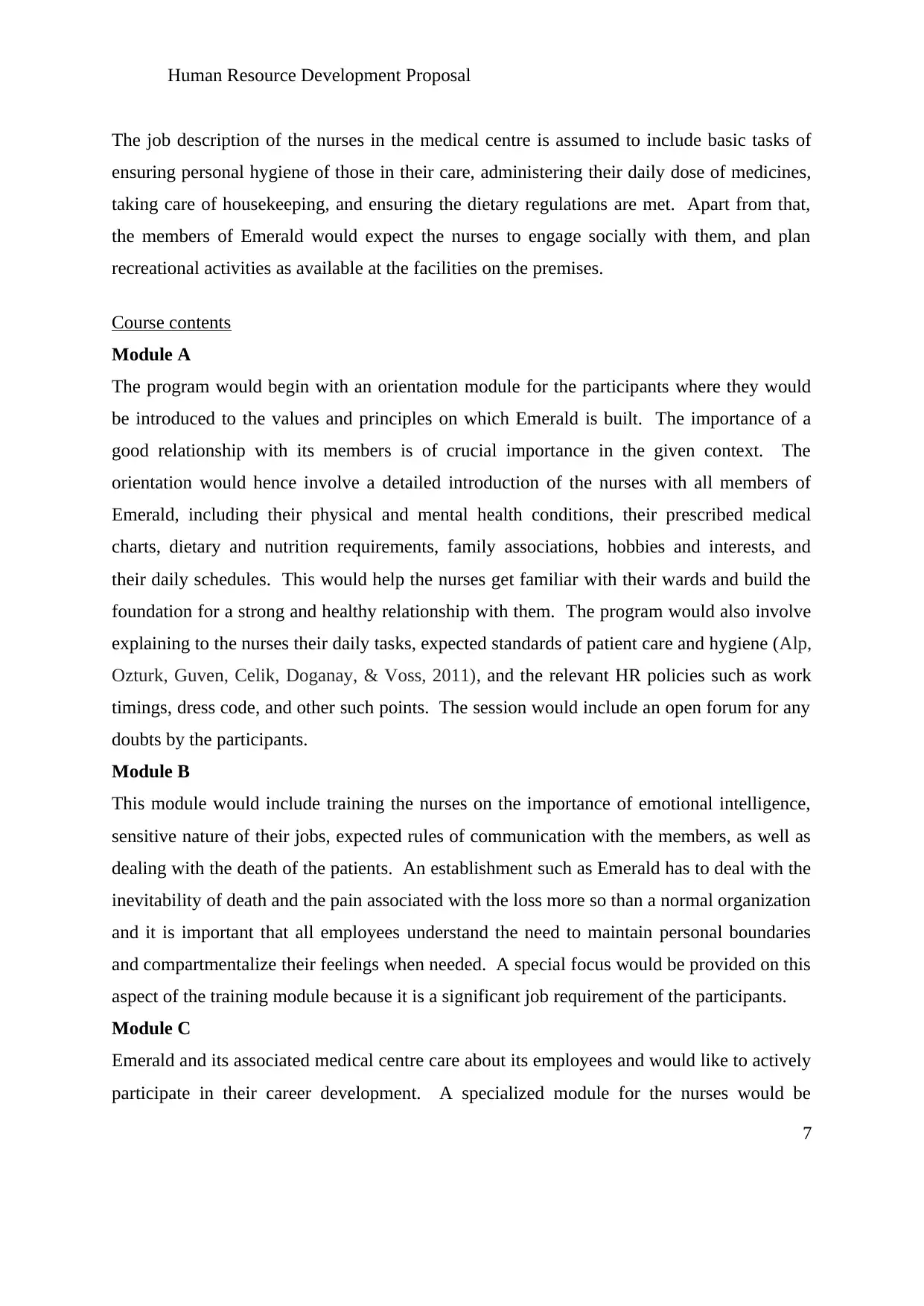
Human Resource Development Proposal
The job description of the nurses in the medical centre is assumed to include basic tasks of
ensuring personal hygiene of those in their care, administering their daily dose of medicines,
taking care of housekeeping, and ensuring the dietary regulations are met. Apart from that,
the members of Emerald would expect the nurses to engage socially with them, and plan
recreational activities as available at the facilities on the premises.
Course contents
Module A
The program would begin with an orientation module for the participants where they would
be introduced to the values and principles on which Emerald is built. The importance of a
good relationship with its members is of crucial importance in the given context. The
orientation would hence involve a detailed introduction of the nurses with all members of
Emerald, including their physical and mental health conditions, their prescribed medical
charts, dietary and nutrition requirements, family associations, hobbies and interests, and
their daily schedules. This would help the nurses get familiar with their wards and build the
foundation for a strong and healthy relationship with them. The program would also involve
explaining to the nurses their daily tasks, expected standards of patient care and hygiene (Alp,
Ozturk, Guven, Celik, Doganay, & Voss, 2011), and the relevant HR policies such as work
timings, dress code, and other such points. The session would include an open forum for any
doubts by the participants.
Module B
This module would include training the nurses on the importance of emotional intelligence,
sensitive nature of their jobs, expected rules of communication with the members, as well as
dealing with the death of the patients. An establishment such as Emerald has to deal with the
inevitability of death and the pain associated with the loss more so than a normal organization
and it is important that all employees understand the need to maintain personal boundaries
and compartmentalize their feelings when needed. A special focus would be provided on this
aspect of the training module because it is a significant job requirement of the participants.
Module C
Emerald and its associated medical centre care about its employees and would like to actively
participate in their career development. A specialized module for the nurses would be
7
The job description of the nurses in the medical centre is assumed to include basic tasks of
ensuring personal hygiene of those in their care, administering their daily dose of medicines,
taking care of housekeeping, and ensuring the dietary regulations are met. Apart from that,
the members of Emerald would expect the nurses to engage socially with them, and plan
recreational activities as available at the facilities on the premises.
Course contents
Module A
The program would begin with an orientation module for the participants where they would
be introduced to the values and principles on which Emerald is built. The importance of a
good relationship with its members is of crucial importance in the given context. The
orientation would hence involve a detailed introduction of the nurses with all members of
Emerald, including their physical and mental health conditions, their prescribed medical
charts, dietary and nutrition requirements, family associations, hobbies and interests, and
their daily schedules. This would help the nurses get familiar with their wards and build the
foundation for a strong and healthy relationship with them. The program would also involve
explaining to the nurses their daily tasks, expected standards of patient care and hygiene (Alp,
Ozturk, Guven, Celik, Doganay, & Voss, 2011), and the relevant HR policies such as work
timings, dress code, and other such points. The session would include an open forum for any
doubts by the participants.
Module B
This module would include training the nurses on the importance of emotional intelligence,
sensitive nature of their jobs, expected rules of communication with the members, as well as
dealing with the death of the patients. An establishment such as Emerald has to deal with the
inevitability of death and the pain associated with the loss more so than a normal organization
and it is important that all employees understand the need to maintain personal boundaries
and compartmentalize their feelings when needed. A special focus would be provided on this
aspect of the training module because it is a significant job requirement of the participants.
Module C
Emerald and its associated medical centre care about its employees and would like to actively
participate in their career development. A specialized module for the nurses would be
7
Paraphrase This Document
Need a fresh take? Get an instant paraphrase of this document with our AI Paraphraser
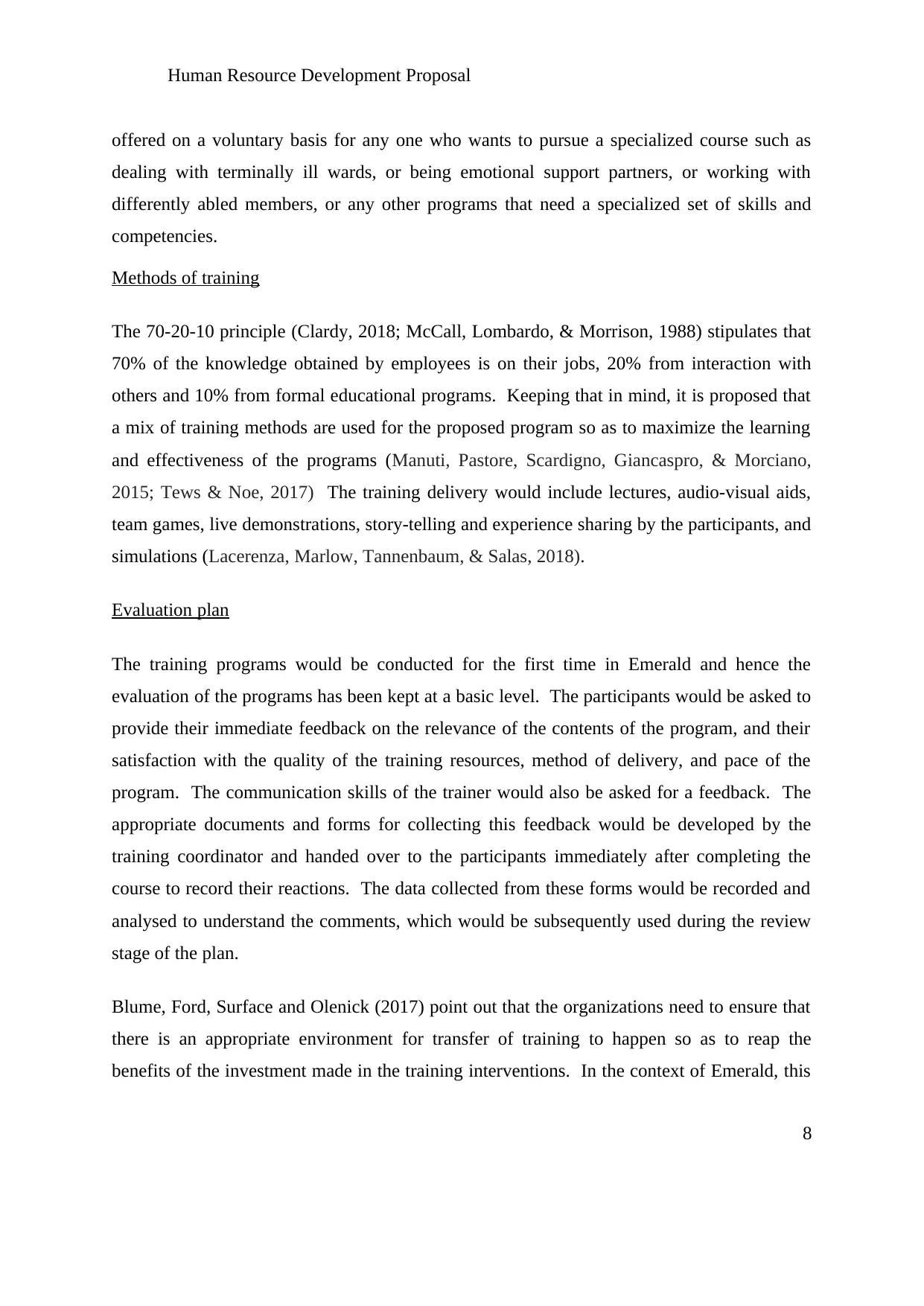
Human Resource Development Proposal
offered on a voluntary basis for any one who wants to pursue a specialized course such as
dealing with terminally ill wards, or being emotional support partners, or working with
differently abled members, or any other programs that need a specialized set of skills and
competencies.
Methods of training
The 70-20-10 principle (Clardy, 2018; McCall, Lombardo, & Morrison, 1988) stipulates that
70% of the knowledge obtained by employees is on their jobs, 20% from interaction with
others and 10% from formal educational programs. Keeping that in mind, it is proposed that
a mix of training methods are used for the proposed program so as to maximize the learning
and effectiveness of the programs (Manuti, Pastore, Scardigno, Giancaspro, & Morciano,
2015; Tews & Noe, 2017) The training delivery would include lectures, audio-visual aids,
team games, live demonstrations, story-telling and experience sharing by the participants, and
simulations (Lacerenza, Marlow, Tannenbaum, & Salas, 2018).
Evaluation plan
The training programs would be conducted for the first time in Emerald and hence the
evaluation of the programs has been kept at a basic level. The participants would be asked to
provide their immediate feedback on the relevance of the contents of the program, and their
satisfaction with the quality of the training resources, method of delivery, and pace of the
program. The communication skills of the trainer would also be asked for a feedback. The
appropriate documents and forms for collecting this feedback would be developed by the
training coordinator and handed over to the participants immediately after completing the
course to record their reactions. The data collected from these forms would be recorded and
analysed to understand the comments, which would be subsequently used during the review
stage of the plan.
Blume, Ford, Surface and Olenick (2017) point out that the organizations need to ensure that
there is an appropriate environment for transfer of training to happen so as to reap the
benefits of the investment made in the training interventions. In the context of Emerald, this
8
offered on a voluntary basis for any one who wants to pursue a specialized course such as
dealing with terminally ill wards, or being emotional support partners, or working with
differently abled members, or any other programs that need a specialized set of skills and
competencies.
Methods of training
The 70-20-10 principle (Clardy, 2018; McCall, Lombardo, & Morrison, 1988) stipulates that
70% of the knowledge obtained by employees is on their jobs, 20% from interaction with
others and 10% from formal educational programs. Keeping that in mind, it is proposed that
a mix of training methods are used for the proposed program so as to maximize the learning
and effectiveness of the programs (Manuti, Pastore, Scardigno, Giancaspro, & Morciano,
2015; Tews & Noe, 2017) The training delivery would include lectures, audio-visual aids,
team games, live demonstrations, story-telling and experience sharing by the participants, and
simulations (Lacerenza, Marlow, Tannenbaum, & Salas, 2018).
Evaluation plan
The training programs would be conducted for the first time in Emerald and hence the
evaluation of the programs has been kept at a basic level. The participants would be asked to
provide their immediate feedback on the relevance of the contents of the program, and their
satisfaction with the quality of the training resources, method of delivery, and pace of the
program. The communication skills of the trainer would also be asked for a feedback. The
appropriate documents and forms for collecting this feedback would be developed by the
training coordinator and handed over to the participants immediately after completing the
course to record their reactions. The data collected from these forms would be recorded and
analysed to understand the comments, which would be subsequently used during the review
stage of the plan.
Blume, Ford, Surface and Olenick (2017) point out that the organizations need to ensure that
there is an appropriate environment for transfer of training to happen so as to reap the
benefits of the investment made in the training interventions. In the context of Emerald, this
8
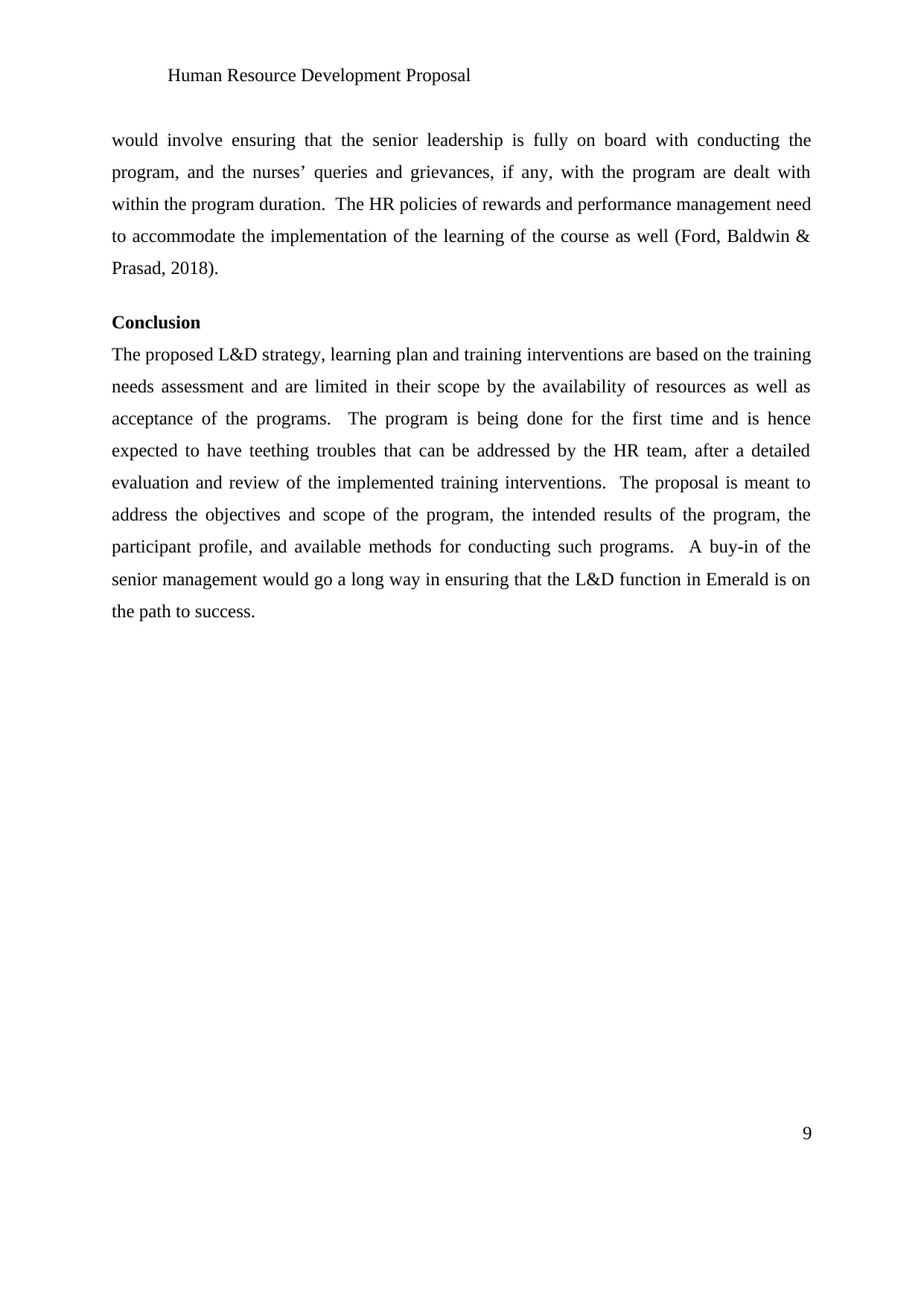
Human Resource Development Proposal
would involve ensuring that the senior leadership is fully on board with conducting the
program, and the nurses’ queries and grievances, if any, with the program are dealt with
within the program duration. The HR policies of rewards and performance management need
to accommodate the implementation of the learning of the course as well (Ford, Baldwin &
Prasad, 2018).
Conclusion
The proposed L&D strategy, learning plan and training interventions are based on the training
needs assessment and are limited in their scope by the availability of resources as well as
acceptance of the programs. The program is being done for the first time and is hence
expected to have teething troubles that can be addressed by the HR team, after a detailed
evaluation and review of the implemented training interventions. The proposal is meant to
address the objectives and scope of the program, the intended results of the program, the
participant profile, and available methods for conducting such programs. A buy-in of the
senior management would go a long way in ensuring that the L&D function in Emerald is on
the path to success.
9
would involve ensuring that the senior leadership is fully on board with conducting the
program, and the nurses’ queries and grievances, if any, with the program are dealt with
within the program duration. The HR policies of rewards and performance management need
to accommodate the implementation of the learning of the course as well (Ford, Baldwin &
Prasad, 2018).
Conclusion
The proposed L&D strategy, learning plan and training interventions are based on the training
needs assessment and are limited in their scope by the availability of resources as well as
acceptance of the programs. The program is being done for the first time and is hence
expected to have teething troubles that can be addressed by the HR team, after a detailed
evaluation and review of the implemented training interventions. The proposal is meant to
address the objectives and scope of the program, the intended results of the program, the
participant profile, and available methods for conducting such programs. A buy-in of the
senior management would go a long way in ensuring that the L&D function in Emerald is on
the path to success.
9
⊘ This is a preview!⊘
Do you want full access?
Subscribe today to unlock all pages.

Trusted by 1+ million students worldwide
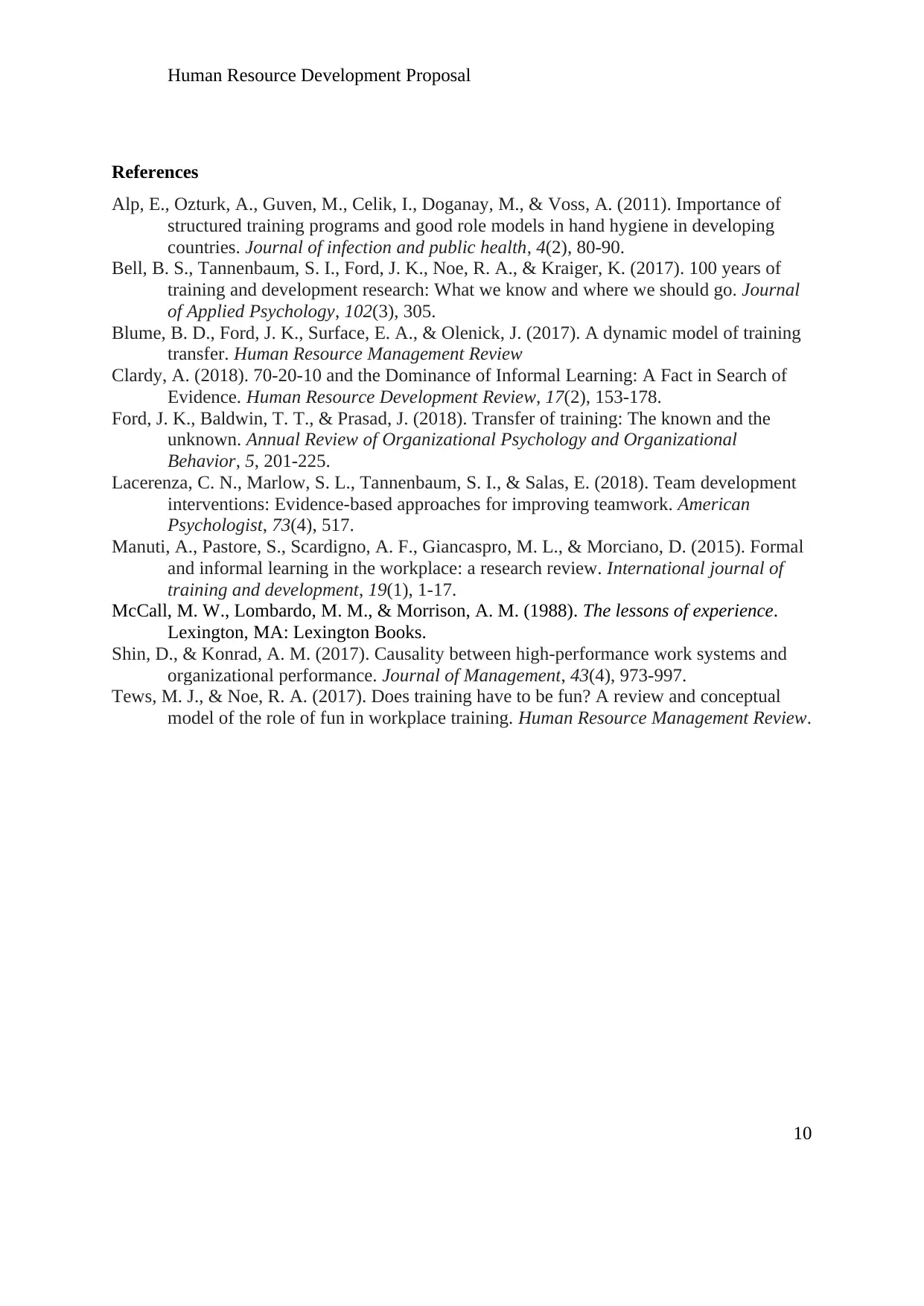
Human Resource Development Proposal
References
Alp, E., Ozturk, A., Guven, M., Celik, I., Doganay, M., & Voss, A. (2011). Importance of
structured training programs and good role models in hand hygiene in developing
countries. Journal of infection and public health, 4(2), 80-90.
Bell, B. S., Tannenbaum, S. I., Ford, J. K., Noe, R. A., & Kraiger, K. (2017). 100 years of
training and development research: What we know and where we should go. Journal
of Applied Psychology, 102(3), 305.
Blume, B. D., Ford, J. K., Surface, E. A., & Olenick, J. (2017). A dynamic model of training
transfer. Human Resource Management Review
Clardy, A. (2018). 70-20-10 and the Dominance of Informal Learning: A Fact in Search of
Evidence. Human Resource Development Review, 17(2), 153-178.
Ford, J. K., Baldwin, T. T., & Prasad, J. (2018). Transfer of training: The known and the
unknown. Annual Review of Organizational Psychology and Organizational
Behavior, 5, 201-225.
Lacerenza, C. N., Marlow, S. L., Tannenbaum, S. I., & Salas, E. (2018). Team development
interventions: Evidence-based approaches for improving teamwork. American
Psychologist, 73(4), 517.
Manuti, A., Pastore, S., Scardigno, A. F., Giancaspro, M. L., & Morciano, D. (2015). Formal
and informal learning in the workplace: a research review. International journal of
training and development, 19(1), 1-17.
McCall, M. W., Lombardo, M. M., & Morrison, A. M. (1988). The lessons of experience.
Lexington, MA: Lexington Books.
Shin, D., & Konrad, A. M. (2017). Causality between high-performance work systems and
organizational performance. Journal of Management, 43(4), 973-997.
Tews, M. J., & Noe, R. A. (2017). Does training have to be fun? A review and conceptual
model of the role of fun in workplace training. Human Resource Management Review.
10
References
Alp, E., Ozturk, A., Guven, M., Celik, I., Doganay, M., & Voss, A. (2011). Importance of
structured training programs and good role models in hand hygiene in developing
countries. Journal of infection and public health, 4(2), 80-90.
Bell, B. S., Tannenbaum, S. I., Ford, J. K., Noe, R. A., & Kraiger, K. (2017). 100 years of
training and development research: What we know and where we should go. Journal
of Applied Psychology, 102(3), 305.
Blume, B. D., Ford, J. K., Surface, E. A., & Olenick, J. (2017). A dynamic model of training
transfer. Human Resource Management Review
Clardy, A. (2018). 70-20-10 and the Dominance of Informal Learning: A Fact in Search of
Evidence. Human Resource Development Review, 17(2), 153-178.
Ford, J. K., Baldwin, T. T., & Prasad, J. (2018). Transfer of training: The known and the
unknown. Annual Review of Organizational Psychology and Organizational
Behavior, 5, 201-225.
Lacerenza, C. N., Marlow, S. L., Tannenbaum, S. I., & Salas, E. (2018). Team development
interventions: Evidence-based approaches for improving teamwork. American
Psychologist, 73(4), 517.
Manuti, A., Pastore, S., Scardigno, A. F., Giancaspro, M. L., & Morciano, D. (2015). Formal
and informal learning in the workplace: a research review. International journal of
training and development, 19(1), 1-17.
McCall, M. W., Lombardo, M. M., & Morrison, A. M. (1988). The lessons of experience.
Lexington, MA: Lexington Books.
Shin, D., & Konrad, A. M. (2017). Causality between high-performance work systems and
organizational performance. Journal of Management, 43(4), 973-997.
Tews, M. J., & Noe, R. A. (2017). Does training have to be fun? A review and conceptual
model of the role of fun in workplace training. Human Resource Management Review.
10
Paraphrase This Document
Need a fresh take? Get an instant paraphrase of this document with our AI Paraphraser
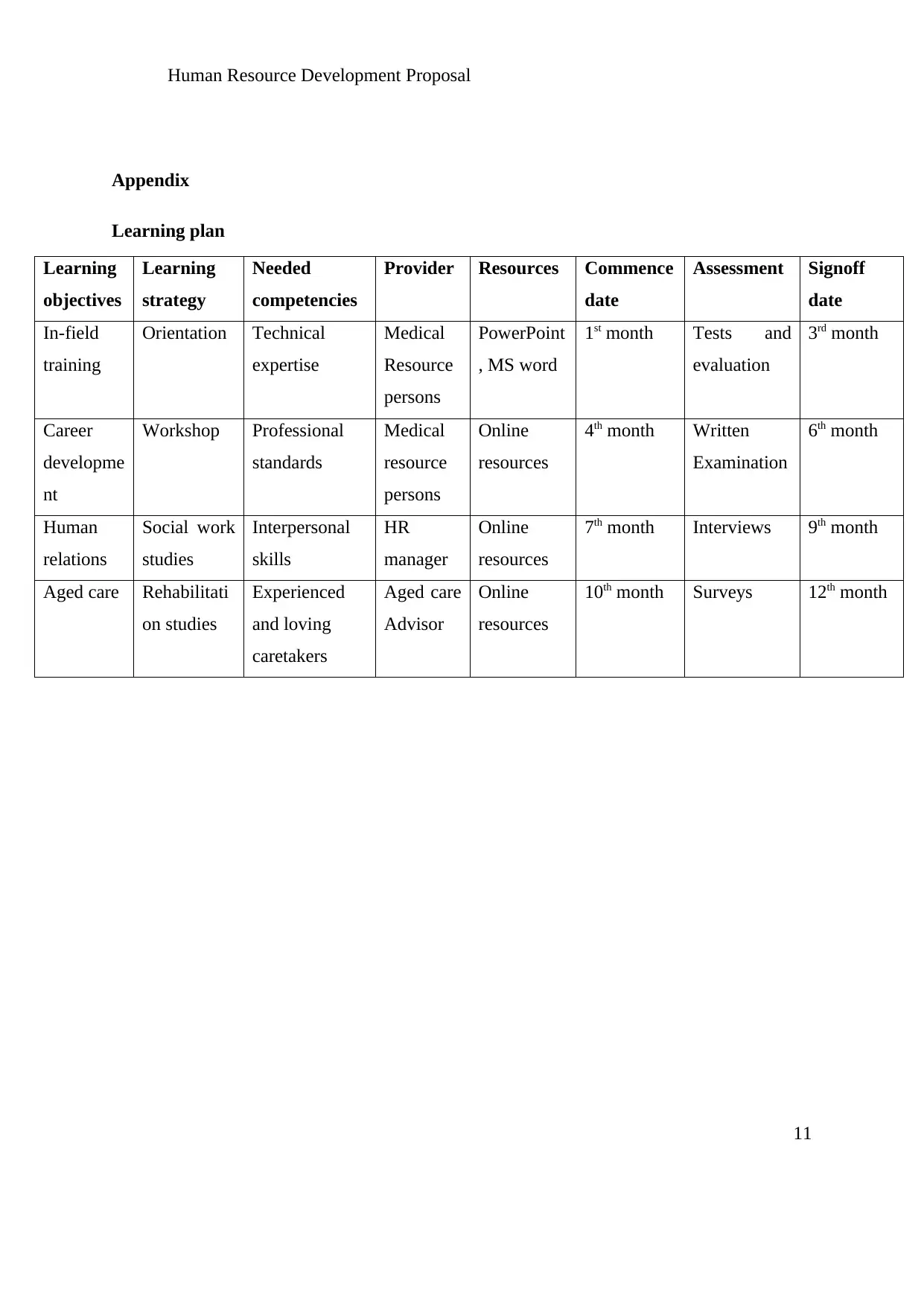
Human Resource Development Proposal
Appendix
Learning plan
Learning
objectives
Learning
strategy
Needed
competencies
Provider Resources Commence
date
Assessment Signoff
date
In-field
training
Orientation Technical
expertise
Medical
Resource
persons
PowerPoint
, MS word
1st month Tests and
evaluation
3rd month
Career
developme
nt
Workshop Professional
standards
Medical
resource
persons
Online
resources
4th month Written
Examination
6th month
Human
relations
Social work
studies
Interpersonal
skills
HR
manager
Online
resources
7th month Interviews 9th month
Aged care Rehabilitati
on studies
Experienced
and loving
caretakers
Aged care
Advisor
Online
resources
10th month Surveys 12th month
11
Appendix
Learning plan
Learning
objectives
Learning
strategy
Needed
competencies
Provider Resources Commence
date
Assessment Signoff
date
In-field
training
Orientation Technical
expertise
Medical
Resource
persons
PowerPoint
, MS word
1st month Tests and
evaluation
3rd month
Career
developme
nt
Workshop Professional
standards
Medical
resource
persons
Online
resources
4th month Written
Examination
6th month
Human
relations
Social work
studies
Interpersonal
skills
HR
manager
Online
resources
7th month Interviews 9th month
Aged care Rehabilitati
on studies
Experienced
and loving
caretakers
Aged care
Advisor
Online
resources
10th month Surveys 12th month
11
1 out of 11
Related Documents
Your All-in-One AI-Powered Toolkit for Academic Success.
+13062052269
info@desklib.com
Available 24*7 on WhatsApp / Email
![[object Object]](/_next/static/media/star-bottom.7253800d.svg)
Unlock your academic potential
Copyright © 2020–2025 A2Z Services. All Rights Reserved. Developed and managed by ZUCOL.





